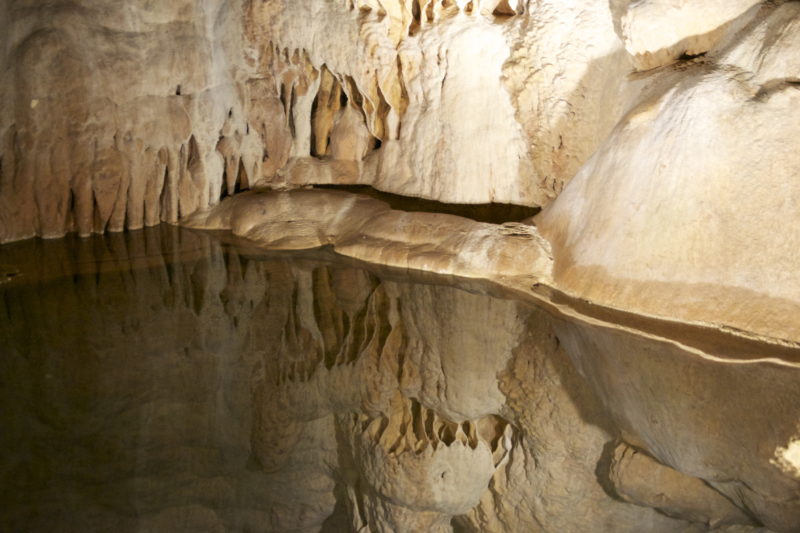
Leave it to Heuer to read about one of the most fascinating discoveries of the last decade and have her wonder about parenting modes. Yup. That’s me. Wondering how Maman manages to let a 12 year old dig rubble for three years to excavate a cave entrance that his Papa had speculated might be there. Just think, no helicopter parenting, no apron strings tied to a kid’s ankle, just hand him a shovel and tell him to have fun….
 So he digs a 30 meter long passage and has the thinnest member of the local spelunking club climb into Bruniquel cave in France. Another almost half kilometer on they find something mind boggling: “a vast chamber where several stalagmites had been deliberately broken. Most of the 400 pieces had been arranged into two rings—a large one between 4 and 7 metres across, and a smaller one just 2 metres wide. Others had been propped up against these donuts. Yet others had been stacked into four piles. Traces of fire were everywhere, and there was a mass of burnt bones. ” I am quoting from the attached article here: http://www.theatlantic.com/science/archive/2016/05/the-astonishing-age-of-a-neanderthal-cave-construction-site/484070/
So he digs a 30 meter long passage and has the thinnest member of the local spelunking club climb into Bruniquel cave in France. Another almost half kilometer on they find something mind boggling: “a vast chamber where several stalagmites had been deliberately broken. Most of the 400 pieces had been arranged into two rings—a large one between 4 and 7 metres across, and a smaller one just 2 metres wide. Others had been propped up against these donuts. Yet others had been stacked into four piles. Traces of fire were everywhere, and there was a mass of burnt bones. ” I am quoting from the attached article here: http://www.theatlantic.com/science/archive/2016/05/the-astonishing-age-of-a-neanderthal-cave-construction-site/484070/
 But now to my real wondering: how can it be that even in science there is so much happening due to pure chance? I am not referring to the determination of locals to explore their environs. The cave was discovered in 1990. By 1999 archeologist Francois Rouzaud had decided, by means of carbon dating the bear bones, that the stalagmite rings were older than any know cave painting, some 46.000 years or so, and thus could not have been the work of Homo Sapiens but the Neanderthals. He died of a heart attack that very year. Almost 15 years later, another caver who is also a specialist in stalagmites happens to vacation in the region. She hears about the cave, tests the stalagmites themselves with more modern means and voilà, they are actually 176,500 years old, give or take a few millennia. Given the nature of the rings, and the absence of functional items, or tools, scientists are now speculating this was a ritual place. Furthermore there are red and black streaks that are applied to diverse areas, hinting at the controlled use of fire hot enough to crack rocks. Views of social organization and communication patterns of Neanderthals are revised as we speak, following these discoveries. http://nautil.us/issue/18/genius/our-neanderthal-complex
But now to my real wondering: how can it be that even in science there is so much happening due to pure chance? I am not referring to the determination of locals to explore their environs. The cave was discovered in 1990. By 1999 archeologist Francois Rouzaud had decided, by means of carbon dating the bear bones, that the stalagmite rings were older than any know cave painting, some 46.000 years or so, and thus could not have been the work of Homo Sapiens but the Neanderthals. He died of a heart attack that very year. Almost 15 years later, another caver who is also a specialist in stalagmites happens to vacation in the region. She hears about the cave, tests the stalagmites themselves with more modern means and voilà, they are actually 176,500 years old, give or take a few millennia. Given the nature of the rings, and the absence of functional items, or tools, scientists are now speculating this was a ritual place. Furthermore there are red and black streaks that are applied to diverse areas, hinting at the controlled use of fire hot enough to crack rocks. Views of social organization and communication patterns of Neanderthals are revised as we speak, following these discoveries. http://nautil.us/issue/18/genius/our-neanderthal-complex
And yet sentences like these (from a major paleontology textbook –Fossil Men by M. Boule) – still populate so many heads, wiggling their way into the racism of the present…“There is hardly a more rudimentary or degraded form of industry than our Mousterian [Neanderthal] Man… [T]he brutish appearance of this energetic and clumsy body, of the heavy-jawed skull… declares the predominance of functions of a purely vegetative or bestial kind over the functions of mind.”
Time to stop wondering and to begin to educate! Good place to start is Daniel Povinelli’s Folk Physics for Apes.
Photographs from cave with no name I explored in Texas. You have to like bats to be down there….





